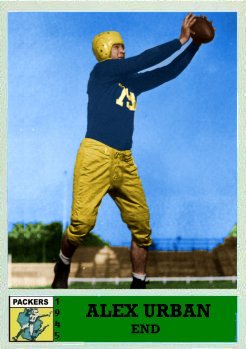

Don Hutson finally retired in 1946 after threatening to for several seasons, and the team’s decline began. Curly Lambeau lost the one piece that allowed him to continue with success in a football world that was passing him by. The team slipped to 6-5, third in the West, but the offense dropped to eighth by scoring just 148 points. Defensively, they were second by giving up just 158 points. In a season of league-wide parity, there were only two teams with losing records, and the Packers beat them both, but were just 4-5 against the rest of the league—2-3 at home and a surprising 4-1 on the road.
Irv Comp again led the team in passing yards, but he completed just 28% of his passes and threw for only 333 yards. Tony Canadeo was second with 189 yards passing on just seven completions. Overall, the team threw for four touchdowns and 18 interceptions. With such an ineffective passing attack, the Packers ran the ball 76% of the time, up from 63% the year before and 56% in 1942 when Cecil Isbell was still on board.
Tony Canadeo led the team with 476 yards rushing and was followed by Ted Fritsch’s 444 and rookie Walt Schlinkman’s 379. Clyde Goodnight and Nolan Luhn tied for the lead in receptions with 16 apiece. Fritsch led the NFL in scoring with 100 points. Herman Rohrig led the squad in interceptions on defense with five. Fritsch and Charley Brock were named All-Pro.
Fighting against the fledgling All-America Football Conference, the underfunded Packers were not able to sign top draft pick fullback Johnny Strzykalski. In fact, just two 1946 picks made the team, third rounder Bob Nussbaumer and 30th rounder Al Sparlis. The team did enjoy an influx of rookies from War Years drafts, though, including: Urban Odson (1942-1), Dick WIldung (1943-1), Bob Forte (1943-11), Merv Pregulman (1944-1), Walt Schlinkman (1945-1) and Don Wells (1945-6).
The ‘46 season was the Packers’ 25th in the NFL and the Press Gazette named the following All-Time team:
Ends: Hutson and Lavie Dilweg
Tackles: Cal Hubbard and Cub Buck
Guards: Mike Michalske and Buckets Goldenberg
Center: Charley Brock
Backs: Arnie Herber, Johnny Blood, Verne Lewellen and Clarke Hinkle
















All custom cards are colorized.

















































